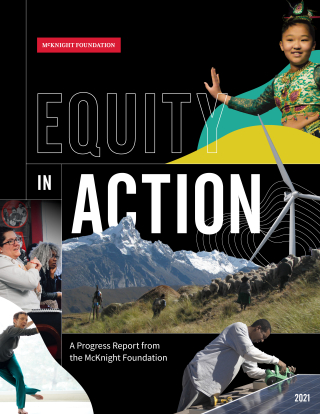Turning Aspiration into Action
A New Report Illustrates Equity in Action at the McKnight Foundation
As a communication professional, I am often focused on the weight of words and both the hope and expectation they create. Values-based language can be especially challenging—for example, how do we translate virtues like equity and transparency into concrete action steps? In 2018, the McKnight Foundation released the organization’s first diversity, equity, and inclusion (DEI) statement. Since then, the Foundation’s board and staff have held fast to the tenet that we need to back up our words with actions. Aspiration must transform into action because communities deserve more than good intentions.
A new Equity in Action report documents examples of shifts we’ve taken at the Foundation to tilt toward a more diverse, inclusive, and equity-oriented organization since the DEI statement’s release. In the past three years, McKnight has made changes in how we use our public voice, make grants, invest funds, convene partners, and work with vendors. McKnight’s DEI efforts are a work in progress, and while this work has not always followed a smooth or linear path, the Foundation has indeed made progress.
Impact through Multiple Roles
As a private foundation, we’ve long recognized that we can create impact through multiple roles that include—and extend far beyond—grantmaking. These six identities—as identified in the DEI statement—are funder, convenor, thought leader, employer, economic entity, and institutional investor. The Equity in Action report gives examples of action steps we’ve taken in those areas.
$32 Million for a More Equitable Minnesota. Using an inclusive process, McKnight designed an entirely new program focused on building a more equitable and inclusive Minnesota. With a projected annual grantmaking budget of $32 million starting in 2022, Vibrant & Equitable Communities is one of the largest programs at McKnight. In addition, all of McKnight’s programs—whether addressing climate change, supporting working artists, advancing collaborative crop research, or funding innovative neuroscience research—are committed to embedding equity as a through-line in our grantmaking.
Diverse Leadership across the Foundation. As an employer, McKnight has dramatically increased the diversity of its senior leaders and program and operations directors. The Foundation’s board selected Tonya Allen, a longtime champion of equity and inclusion, as president in late 2020. She heads an all-women, majority-BIPOC team with diverse lived experiences. In fact, 10 of the 17 McKnight team members (or 59%) who hold director level positions or above identify as Black, Indigenous, or people of color.
Speaking Up for Justice. As a thought leader, McKnight has increased the use of its public voice to stand in solidarity with our communities, collectively grieve acts of racial violence, and advocate for a more participatory democracy and equitable distribution of federal funds. For example, in the past few years, we have issued or signed on to public statements—including the We Stand for Democracy statement, AAPIP’s Open Letter to Philanthropy, and the Philanthropic Collective to Combat Anti-Blackness and Realize Racial Justice—that stood for our core value of equity, and represented ways we embed an equity approach into all areas of our work.
The Equity in Action report gives numerous examples of inclusive impact investments, convenings on equity topics, and efforts to pay more attention to the Foundation’s purchasing decisions. For example, today approximately 45 percent of our endowment is mission-aligned, and, among other investments, we specifically invest in creating affordable housing, supporting small businesses owned by people of color, and making sure low to moderate income communities have access to renewable energy and efficiency solutions. For our convenings, we created inclusive guidelines that considered ways to create welcoming environments and access, and to lift the contributions of Black, Indigenous, and people of color participants. And the Foundation just adopted a new vendor policy to promote fairness and inclusion, and to increase opportunities for underrepresented groups to provide goods and services to the Foundation.
Aspiration must transform into action because communities deserve more than good intentions.
Joining Together to Set New Patterns for Equity
In her book Emergent Strategy, activist and organizer adrienne maree brown speaks to what it takes to successfully enact change. Using the analogy of fractals—infinitely complex patterns that are created by repeating a simple process over and over—she encourages advocates to understand that the small, consistent practices impact the large. “What we practice at the small scale sets the pattern for the whole system,” she writes.
While some of the steps featured in the Equity in Action report are modest and nascent, even the smallest of these actions creates new precedents and patterns. We still have much more work to do and more to learn. We know the roots of inequity are deep and structural. The Foundation is committed to continuing to learn, listen, reflect, and speak up—with transparency—to advance equity inside and outside the Foundation. Most importantly, we will continue to act.
As more foundations make public commitments to racial equity, McKnight’s leadership hopes that collective and open reporting of our experiences will speed up progress and encourage mutual accountability. Together, we can combine our efforts to enact change and move larger systems.







